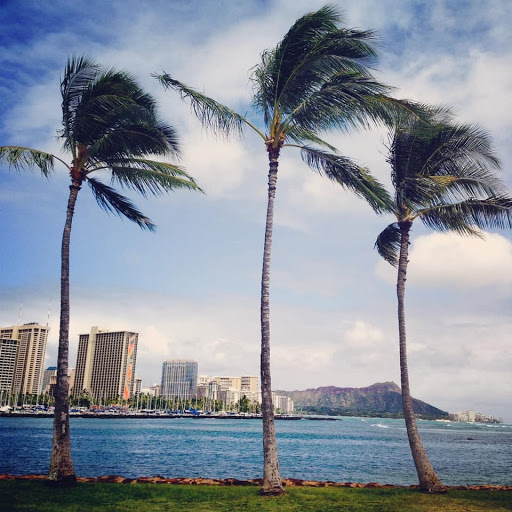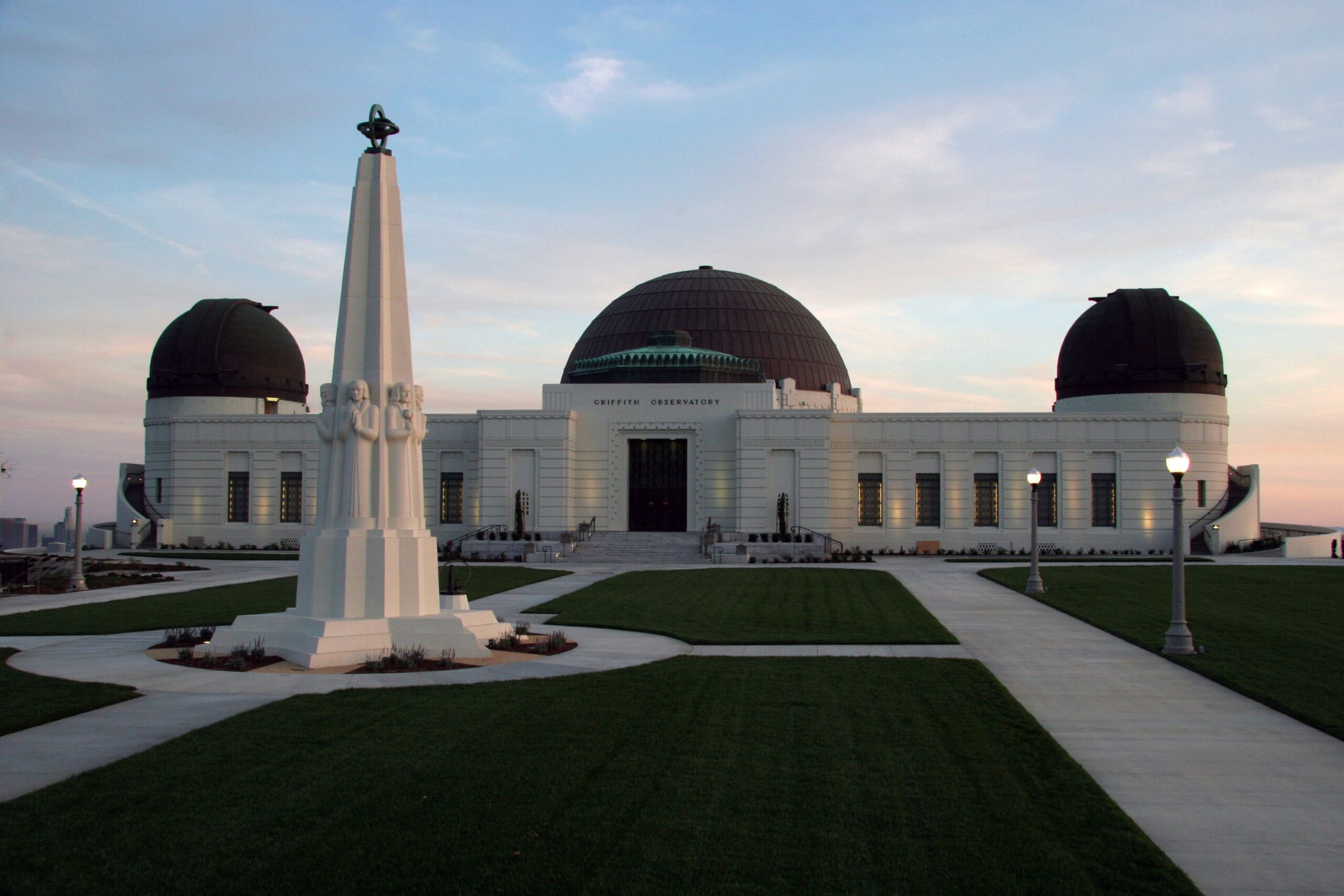Swaying palm trees with Waikiki and Diamond Head in the distance
(Credit: Andrea Christman Rompré)
(WAIKIKI, Honolulu) — Green palm fronds flutter high above the empty northern end of Waikiki Beach. A warm breeze floats the fragrance of plumeria tinged with sea salt through the air. No longer do exhaust fumes from tourist-laden buses nor the rank odor of sweat-drenched bodies running to and from the ocean taint the atmosphere. Today, the streets are so devoid of traffic. A woman rides a bike down the middle of the road, singing and talking to herself.
The COVID-19 pandemic is killing the tourist-dependent economy but reviving the feel-good “Aloha Spirit” that was lost, locals say, to Honolulu’s overdevelopment as Hawaii’s top visitor destination. Before the collapse of tourism, Hawaii Tourism Authority (HTA) surveys found that attitudes among visitors and residents alike were becoming more negative as the number of visitors increased, says Frank Haas, HTA’s former vice-president of marketing.
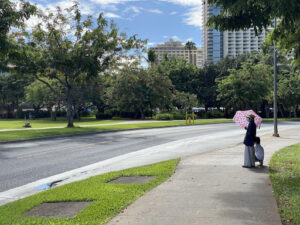
Boy and woman wait for a bus.
“They love visitors. If the visitors only stayed in Waikiki, they’d have no problem,” says Bob Hampton, president of Waikiki Beach Activities, Ltd. People have been complaining about vacation rentals in their neighborhoods. Their communities were no longer safe from the problems caused by encroaching tourism.
Haas agrees. “Traffic congestion, overcrowding, and damage to the environment are among the greatest concerns to residents,” Haas says. “Visitors also complain about overcrowding.”
Waikiki district boasts expensive international restaurants, luxury resorts, and over 30,000 hotel rooms. Advocates hope to reclaim an atmosphere that’s appealing to visitors and locals as the tourist trade recovers.
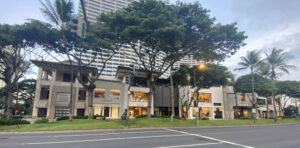
Luxury Row, Waikiki, Honolulu, November 2020 [Credit: Barbi Walker-Walsh]
Further along Waikiki Beach, surf racks jut out from the sand like the ribs of a dinosaur. Out on the waves, though, a handful of surfers pepper the turquoise waters of Hawaii’s most famous beach. Even in the throes of a pandemic, surfers still surf. Locals who shunned Waikiki crowds are returning for the first time in decades, and they love what they see, says Denby Fawcett, longtime Hawaii journalist, and reporter for Honolulu Civil Beat, who shared her ideas for how tourism should return to Hawaii in a recent commentary.
“Many don’t want to go back to the time before COVID,” she says.
Surfing, Tourism and the Aloha Spirit
Located on Oahu’s island, Waikiki is known for its beautiful beaches and high-end shopping in Honolulu’s capital city. Waikiki is where people go to visit the “big city” in Hawaii. More city life than a resort-style vacation, but here you can have both—nightlife and relaxing paradise while surfing its smooth-rolling waves in the warm Pacific Ocean.
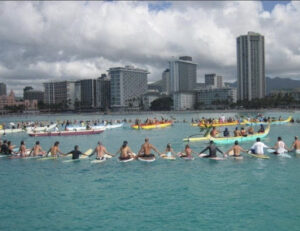
Celebrating the life of Donald Takayama, a legendary surfer and surfboard shaper from Waikiki; November 11, 2012 [Credit: Marie Fiel Watkins]
Waikiki’s culture is rooted in surfing, tourism, and the Aloha Spirit—from the early 1800s to today, all three continue to evolve with time. But it was in the mid-’70s that tourism became the leading industry for Hawaii. Waikiki has gone through many revitalizations, and many locals say their culture of the Aloha Spirit has lost its authenticity. Aloha means many things, but according to the Center for Labor Education and Research, “Aloha Spirit is the coordination of mind and heart within each person. It brings each person to the self. Each person must think and emote good feelings to others.”
Many locals say visitors don’t understand or respect the Aloha Spirit.
“We had all these people coming over from the mainland telling us what they thought Hawaii was. You know, grass skirts, coconut bras… And we wanted to keep our culture intact,” says Hampton. Fed up with the loss of culture, Hampton opened a locals-only restaurant and nightclub. In the early 1970s, he opened Territorial Tavern, which is credited for the beginning of slack-key guitar playing.
Modern Day Waikiki Revamped: Just Another Day at the Mall
Picture a mall just like any mall in middle America, only this one is, as Joni Mitchell sings in her iconic lyrics, “paved paradise and put up a parking lot.” That song, “Big Yellow Taxi,” was inspired by her time in Honolulu. Mitchell is rumored to have referenced the Royal Hawaiian when she sang about the famous and only pink hotel in Waikiki, as “a pink hotel, a boutique and a swinging hot spot.”
Waikiki’s once-unique Luxury Row no longer differs from Rodeo Drive (which some on Trip Advisor call it) in Beverly Hills or Paris’ Champs de Élysées, once known as the most famous and exclusive shopping avenue in the world.
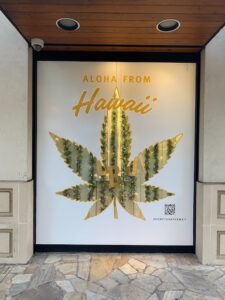
A sign of things to come in the Aloha state and Waikiki [Credit: Barbi Walker-Walsh]
Tourism Fatigue – COVID-19 Killed Tourism But Saved Paradise
Visitor counts had continued to surge since the turn of the century, especially since the Great Recession until the pandemic shut down travel. With self-imposed quarantines, Hawaii gambled on visitors being discouraged from coming to paradise and quarantine. It worked, and for the first time in decades, residents saw their paradise again.
But the visitor restrictions put a substantial financial burden on the economy. Oahu’s targeted growth had exploded for the last decade or so. So much construction was going on, that the running joke was that the construction crane was the state bird, says Hampton.
Jenni Smith, a transplant from Fountain Hills, Arizona, agreed. “Locals didn’t go to Waikiki,” says Smith, who lived and worked in Honolulu as a nurse for five years. She said that even though she was new to the area, she didn’t even go to Waikiki, “It was just too crowded,” she says. “That’s where the tourists go.”
Last year, 10.9 million tourists visited Hawaii, with about 4.8 million staying exclusively on Oahu’s island. However, the Economic Research Organization at the University of Hawaii (UHERO) noted in its 2019 report that more visitors did not mean things got better for the state. According to the report, many underlying problems existed when focusing only on the number of tourists. Tourism wasn’t less of a positive contribution to the economy. More visitors were spending less per capita in 2019 today than they did in 1989. The trend had been going on for three decades, and things needed to change soon.
Spending by tourists has decreased over the years as the number of tourists increased. In 2019, the largest expenditure by visitors to Oahu, the island of Waikiki, was on shopping. According to Hawaii Tourism, the average shopping expenditure was $22 per person, down from $31 per person in 2018.
The pandemic soured the numbers drastically. Last October, Oahu had 469,339 visitors compared to 36,007 visitors in October of 2020 after the state opened up for arrivals, according to the Hawaii Tourism Authority (HTA). That is a decrease of nearly 83 percent from the year before.
But with tourism down, locals are enjoying the tourist amenities.
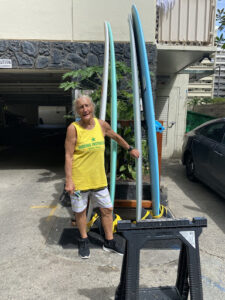
Karen Schmidt, local surf instructor says she’s busy with locals returning to surf [Credit: Barbi Walker-Walsh]
High-tech to the Rescue
Like so many others, Haas had heard about people in Hawaii saying they’d rather tourism not come back at all. Especially after enjoying the tourist-free island, but when he hears that, he says, “My response is, ‘Okay, do you like to eat?’”
Tourism is an excellent source of jobs and the number of people it employs because it’s service-intensive, Haas says. But those jobs tend to be low-paying jobs. And now, with the pandemic and fears about transmission from both travelers and destinations alike, tourism will be slow to recover.
The United Nations COVID-19 Tourism Policy Brief shows the crisis the pandemic has created on tourism is a grave risk to our planet. Haas thinks technology is the answer for a sustainable recovery for Hawaii and the world. And thanks to the pandemic, that technology is moving quickly and more readily available. Now that we are far along into the pandemic, we know more about how it affects various tourism parts, Haas says. And diversifying Hawaii’s economy is paramount to “rising from the ashes,” as he has written.
Like a good investment portfolio, investing in other means of revenue for the state is the way to go. And with the technology being used in the State of Hawaii’s Safe Travels program and COVID-19 portal are great tools. Haas says the goal shouldn’t be fewer visitors but more educated ones. Tourists should appreciate the land and the people’s culture they’re visiting. Technology is a way to both educate and manage visitors, he says.
On October 15, the state launched its pre-travel testing program, which allows visitors to by-pass the 14-day quarantine with a negative COVID-19 test result from one of the approved testing sites. All visitors must have a COVID-19 test before arriving on the islands. They must also fill out the information on the State of Hawaii’s Safe Travels site. Much like going through customs after arriving from international destinations, passengers must go through a screening upon landing.
Locals and businesses are ready for solutions to the problems that over-tourism has created on the islands. People and organizations on all the islands are already dedicating time and resources to the issues. Now, thanks to the pandemic and the need for technology to fight and manage it, high-trafficked destinations can become more sustainable and resident-friendly destinations. Understanding and figuring out how to do big data and use data analytics like hotels have to manage revenue. The state can use sophisticated technology, too.
“Those are the things we need to figure out now. You gotta do a plan, and we don’t have a statewide, long-range comprehensive plan,” Haas says. “And we need to answer all these questions.” With the pandemic came an awareness of and a need for cultural sensitivity. So can corporations and local businesses work together?
Haas thinks that the islands are big enough for all in the mosaic of Hawaii’s tourism. “There will always be a place for the corporate beach boys, but there will also be places for the people who want a personalized, local experience,” Haas says. “How that plays in terms of balance remains to be seen.”
Hampton says some people tell him the recovery solution is to cut the numbers of visitors down by just going after the rich folks. “Well, you know, in a free democracy, it’s kind of hard to do that other than our marketing,” Hampton says. “And one of the biggest problems we got about restarting tourism is marketing.” Now, as everyone has had time to pause and reflect on a world without tourists, Hawaii can use its cultural roots to bridge the gap from kitsch to authentic with the click of a mouse or a tap on a smartphone.
Maybe this time, technology can help get the message across that the Aloha Spirit means listening to those whose cultures are part of the selling point.
